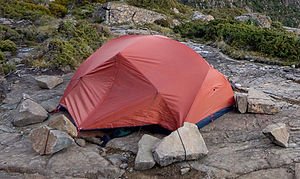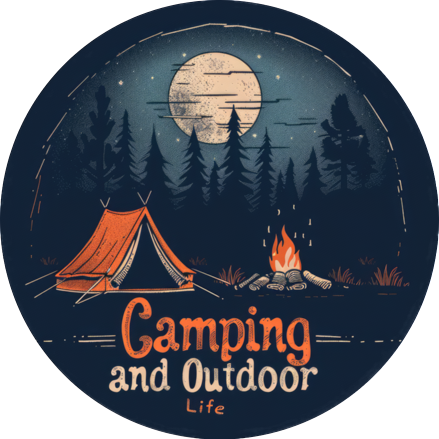Anyone who enjoys the outdoors is undoubtedly aware of the fact that the weather is often contradictory to our wishes and in fact, it can be quite harsh at times. Therefore, if you are a camper, then a properly designed tent is paramount to your comfort and feeling of security when the weather turns inclement. Consequently, it’s extremely important to make certain that your tent is up to the job because, if it isn’t, then you are not going to be a happy camper! Therefore, tent manufactures have created numerous different types of tents in all different sizes, shapes, and price points to accommodate most camper’s needs in nearly any environmental condition.
[avantlink_ad merchant=”REI.com” title=”REI Tent Finder! “][/avantlink_ad]When a novice decides to purchase a new tent, they often find that they are confronted with so many different choices that their mind finds it difficult to process all of the information. Thus, instead of purchasing a tent, they find themselves staring off into space, totally bewildered by all of the different manufactures and models, while their mind attempts to catalog and process all of the differences between them in an attempt to determine why one brand or model is so much more expensive than another. However, with a little knowledge at your disposal, the process of choosing the proper tent for your particular needs can be reduced to a series of simple steps.
The First Step of Tent Selection
So, let’s start with the first step which is contemplating the physical size and weight of the tent. Now, a trip to any well stocked outdoor store or a perusal of a quality outdoor outfitter’s catalog will quickly reveal that there are many different types of tents available:
- Wall Tents
- Dome Tents
- Tent Cots
- Mosquito Tents
- Bivy (bivouac) Sacks
- Wings
- Tarps
- etc.
Also, many of these particular types of tents are available in several different sizes ranging from palatial to minuscule depending on your needs; in fact, they are even available with separate rooms inside! Thus, in order to start narrowing your choices, the first question you should ask yourself is just how big of a tent do you need and how are you going to carry it? Now, the reason that this question is of paramount importance is that if you are going to be carrying the tent in your car, truck, trailer, or horse, then neither size nor weight is likely to be an issue. But, if you are kayak touring or backpacking, then both size and weight are a major issue to be considered. So, the first question to ask yourself when contemplating the purchase of a new tent is, “how much room would I like to have” and, the second question is, “how much room do I truly need”? Then, choose your tent size accordingly. For instance, if bundled size and/or weight are not a major concern, then you might want to choose a “cabin tent” or a large dome tent so that you have plenty of room inside for yourself, any companions you may choose to bring along, and any clothing or gear you choose to keep inside.

If you are car, truck, trailer, or horse camping, then in addition to your large cabin or dome tent, then you might want to bring a tarp or awning along to provide shelter from the sun and/or rain so that you have dry/cool place to cook and lounge outside without experiencing the enclosed feeling you get in a tent. However, if you are canoe or kayak touring then both the bundled size and the weight of the tent become considerably more important because the cargo capacity of both types of watercraft is limited. Therefore, instead of a Wall Tent, a Cabin Tent, or a large Dome Tent, then you would be better off choosing a smaller two or three person dome tent because this type of tent packs down to a reasonably small size and in not excessively heavy and yet, it still provides plenty of room inside.

If you are a backpacker or a wilderness survivalist, then both bundled size and weight become extremely important to you and thus, in this case, you might prefer a Single Person Dome Tent, a Bivy Sack, and/or a Wing instead. Of these three types of shelters, the Single Person Dome Tent provides the greatest amount of interior space but also has the greatest bundled size and weight. Bivy Sacks, on the other hand, are very compact and lightweight and generally incorporate no more than two short poles (some have none) and no tent stakes at all and yet, they still provide fully enclosed protection from the weather. Last, Wings are the lightest in weight and the most compact type of shelter you can carry because they consist of nothing more than a lightweight nylon tarp with riveted holes around the edges and they are often constructed in such a way that they can be configured several different ways.
Another factor to keep in mind is that the larger a tent is, the larger its footprint is and thus, larger tents require more room to set them up in. Also, they are generally more complicated to assemble and disassemble than a smaller tent and thus it requires more work and more time to set them up and take them down.
Second Step of Tent Selection
The second factor to consider when contemplating the purchase of a new tent is the amount of protection it needs to provide. In order to determine this, you must first understand that tents are divided into two categories consisting of three-season tents and four-season tents and the difference between the two is the amount of protection from the elements the tent provides. For instance, three-season tents are specifically designed for camping in spring, summer, and fall and thus, they are less robustly built than four-season tents are. Consequently, they often have fewer tent poles and the poles they do have are often slimmer than those found in four-season tent models. In addition, the fabric of a three season tent is usually of a lighter denier than that used on a four-season tent and thus, they do not retain heat as well, nor do they block the wind as well.
Also, three-season tents generally incorporate front flaps, windows, and a ceiling made from a screen-like, bug proof, nylon fabric which increases ventilation in the tent during the summer months but also feature solid nylon flaps that can be zipped closed over the front door and windows along with a “rain fly” (a solid, nylon, tarp specifically fitted to a particular model of tent) which fits over the entire tent to help shed rain during inclement weather and retain heat during the colder months. Last, while three-season tents do incorporate a tent floor of heavier-duty fabric than the walls, they generally lack the super heavy-duty, waterproof, “bathtub” bottom normally found on four-season tents and thus, they are more prone to leakage caused by accumulating or running ground water during an excessive rainfall.

Four-season tents on the other hand, generally have a greater number of tent poles, each of a larger diameter than three season tents do, and they are generally made from a heavier denier fabric with reinforced seams so that they are able to withstand high winds and heavy snowfalls. In addition, four-season tents generally do not feature the adjustable ventilation system often incorporated in three-season tents so that the interior of a four-season tent remains warmer during the winter months. In addition, four-season tents generally include a fully encompassing rain fly and a “bathtub” style vinyl or rubberized fabric floor that rises approximately six inches up the side of the tent on all sides to prevent standing or running ground water from seeping into the interior of the tent during a heavy rain.
So, if you find yourself confused by the myriad of tent models offered by the many different tent manufactures, then start by determining whether or not you absolutely require a four-season tent or, if a three-season tent will better suite your needs. Then, consider both the size of the tent’s footprint as well as its erected height to make certain that it will provide you with the amount of interior space you require and balance this with the bundled size and weight of the collapsed tent so that it suites your intended method of carrying the tent and then make your choice accordingly.
Last, be aware that the more expensive brands such as of tents Kelty, Mountain Safety Research, The North Face, Outdoor Research, etc, generally incorporate higher quality materials and feature better craftsmanship than less expensive tents do and thus, they generally last longer and provide the user with better protection from inclement weather than inexpensive tents do. So, by following this simple formula, the issue of choosing the correct tent too meet your needs is reduced to little more than a matter of price point and aesthetics.







[…] Unless you’re using a multiple-season tent, the one you use for summer may not be able to withstand the cold weather and snowy condition. What you need is a waterproof tent that will keep you dry during heavy snowfall. A winter tent should also have larger, stronger tent poles to suport the added snow weight. This important piece of camping gear should also be easy to zip up to fully protect you. More details on selecting a tent can be found in our earlier post How to Choose the Proper Tent to Meet Your Outdoor Needs […]